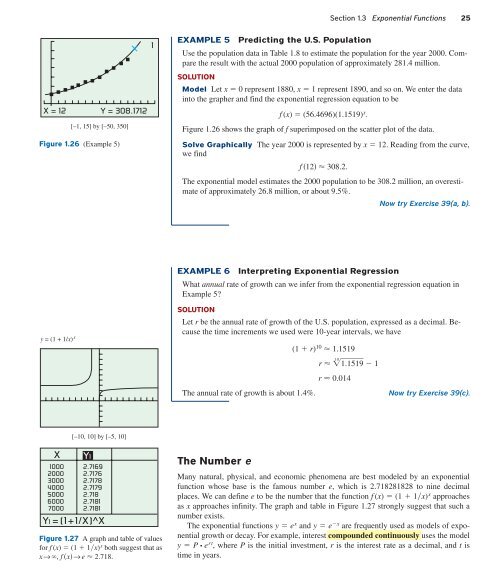Textbook Chapter 1
You also want an ePaper? Increase the reach of your titles
YUMPU automatically turns print PDFs into web optimized ePapers that Google loves.
Section 1.3 Exponential Functions 25<br />
1<br />
EXAMPLE 5<br />
Predicting the U.S. Population<br />
Use the population data in Table 1.8 to estimate the population for the year 2000. Compare<br />
the result with the actual 2000 population of approximately 281.4 million.<br />
X = 12<br />
Y = 308.1712<br />
[–1, 15] by [–50, 350]<br />
SOLUTION<br />
Model Let x 0 represent 1880, x 1 represent 1890, and so on. We enter the data<br />
into the grapher and find the exponential regression equation to be<br />
f (x) (56.4696)(1.1519) x .<br />
Figure 1.26 shows the graph of f superimposed on the scatter plot of the data.<br />
Figure 1.26 (Example 5)<br />
Solve Graphically The year 2000 is represented by x 12. Reading from the curve,<br />
we find<br />
f 12308.2.<br />
The exponential model estimates the 2000 population to be 308.2 million, an overestimate<br />
of approximately 26.8 million, or about 9.5%.<br />
Now try Exercise 39(a, b).<br />
EXAMPLE 6<br />
Interpreting Exponential Regression<br />
What annual rate of growth can we infer from the exponential regression equation in<br />
Example 5?<br />
y = (1 + 1/x) x<br />
SOLUTION<br />
Let r be the annual rate of growth of the U.S. population, expressed as a decimal. Because<br />
the time increments we used were 10-year intervals, we have<br />
(1 r) 10 1.1519<br />
r 10 1.1519 1<br />
r 0.014<br />
The annual rate of growth is about 1.4%.<br />
Now try Exercise 39(c).<br />
[–10, 10] by [–5, 10]<br />
X<br />
1000<br />
2000<br />
3000<br />
4000<br />
5000<br />
6000<br />
7000<br />
Y1<br />
2.7169<br />
2.7176<br />
2.7178<br />
2.7179<br />
2.718<br />
2.7181<br />
2.7181<br />
Y1 = (1+1/X)^X<br />
Figure 1.27 A graph and table of values<br />
for f (x) (1 1x) x both suggest that as<br />
x→ , f x→ e 2.718.<br />
The Number e<br />
Many natural, physical, and economic phenomena are best modeled by an exponential<br />
function whose base is the famous number e, which is 2.718281828 to nine decimal<br />
places. We can define e to be the number that the function f (x) (1 1x) x approaches<br />
as x approaches infinity. The graph and table in Figure 1.27 strongly suggest that such a<br />
number exists.<br />
The exponential functions y e x and y e x are frequently used as models of exponential<br />
growth or decay. For example, interest compounded continuously uses the model<br />
y P • e rt , where P is the initial investment, r is the interest rate as a decimal, and t is<br />
time in years.












